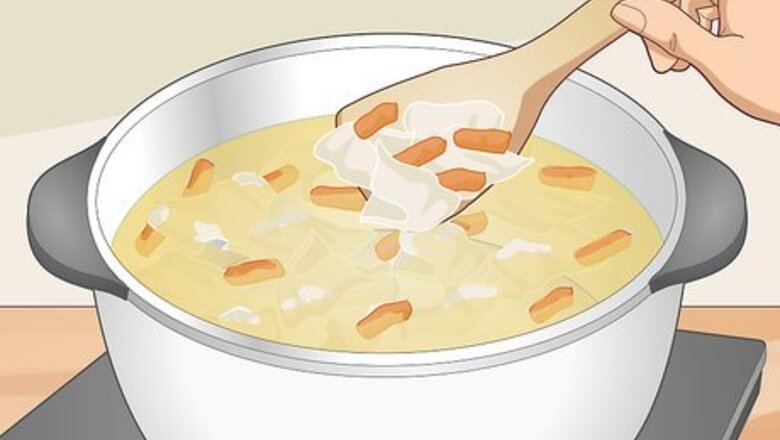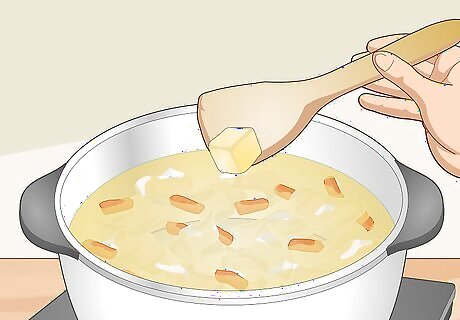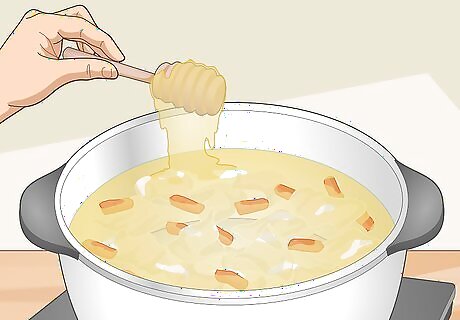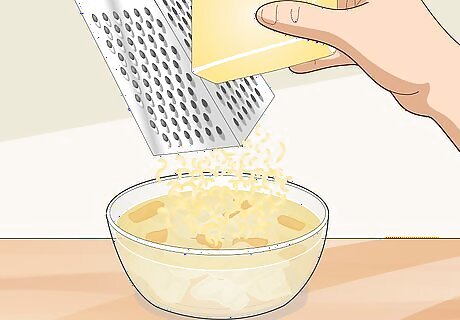
views
Balancing the Flavors while Cooking

Toss in more of the soup’s base ingredients to soak up the spice. The ingredients you add depend on the type of soup you’re making, but try adding more meat, vegetables, rice, or potatoes. The added ingredients in your soup will absorb some of the broth and mask some of the spiciness from the rest of your dish. You can also try foods like grated carrots, beans, corn, squash, or noodles.

Add more broth to help dilute the spices. Use the same broth or stock so you don’t affect the other flavors in your soup. Stir in about ⁄2–1 cup (120–240 ml) of the broth at a time before tasting the soup again. If it still tastes too spicy, keep adding more broth until you’re satisfied with the flavor. You can put additional broth in any kind of soup. If you don’t have any broth, you can also add water instead. You may need to add more salt to reseason your soup.

Pour in whole milk or full-fat yogurt to add more creaminess to your soup. Opt for full-fat products since they’ll be more effective than low-fat alternatives. Start by adding ⁄4–⁄2 cup (59–118 ml) of dairy to your soup at a time and stir it in thoroughly. Test your soup to see if it still tastes spicy, and add more milk or yogurt to the soup until it’s mild enough to eat. This works great for chilis, chowders, and other creamy soups. Avoid using dairy products in hearty stews since the flavors usually don’t interact well together. Full-fat dairy foods have a compound that counteracts capsaicin, which is the chemical that makes food spicy.Variation: If you’re dairy-free, you can also try using soy, coconut, or nut milk, but it may add different flavors to your soup.

Drop in butter or olive oil if you don’t want to affect the overall flavor. Use about 1 tablespoon (15 ml) of butter or oil at a time so you don’t add too much. Mix your soup well until all of the ingredients are thoroughly combined. If your soup still tastes too spicy, put in another 1 tablespoon (15 ml) and mix it again. Butter and oil have fats, which helps neutralize the spice so it’s not as severe.

Pour in 1 US tbsp (15 ml) of lemon juice or vinegar to offset the spice. The acidity in lemon juice and vinegar can help mask the heat and brighten the other flavors in your soup, so stir in 1 tablespoon (15 ml). Try your soup to see if it’s still too spicy for you. If it is, put in another 1 tablespoon (15 ml) at a time until you’re happy with how your soup tastes. Lemon juice can also make other flavors in your soup more prominent. Avoid adding too much lemon juice or vinegar since it could make your soup too sour.

Try mixing in a spoonful of honey or sugar to cut the spice with sweetness. Sometimes, a sweet flavor can counteract spiciness and make your soup taste more balanced. Only add in a spoonful at a time and mix it into the broth. Taste your soup to test the spice level, and mix in more honey or sugar if you still think it’s too hot. This works best in thicker, concentrated soups, like chowders and chilis. Be careful not to add too much sugar, or else your soup may taste too sweet.
Serving Soup with Condiments and Sides

Top your soup with sour cream if you don’t mind thickening it. Scoop a dollop of sour cream into your bowl of soup and stir it into the broth. The fat in the sour cream will help mask the spices and make your soup creamier. If the soup still tastes too spicy, drop in more sour cream until it’s palatable. Sour cream works well for chili, chowder, and taco soup.Variation: If you don’t have sour cream, you can also use full-fat Greek yogurt or a splash of heavy cream.

Sprinkle shredded cheese on your soup to mask the spicy flavor. You can use any kind of cheese you want on your soup, but common choices include Cheddar, Swiss, and Gruyere. Grate the cheese on top of your soup, and mix it together so the cheese melts into the broth. Test the flavor of the soup and add it more cheese if you still think there’s too much heat. Try adding cheeses to soups like chili and chowder. Cheese will sometimes clump together in your soup and could affect the overall texture.

Choose a bland starch to eat as a side to absorb the spice. If you don’t feel like cooking any sides, have bread or crackers along with your soup. Otherwise, you can prepare rice, noodles, quinoa, or potatoes if you want something more substantial. When you have a spoonful of soup, take a bite of starch right after so the spices don’t taste as severe. Spread butter or oil on your side dish since the fats can make the starches even more effective at neutralizing the heat.

Drink milk with your meal to neutralize the heat. Opt for full-fat milk since it will be the most effective at counteracting the spice. If you take a bite of soup and it’s too spicy, immediately take a sip of your milk and swish it around your mouth before swallowing it. You can also drink nut milk or coconut milk since they also have fats.




















Comments
0 comment